weight Citroen C4 DAG 2013.5 2.G Owner's Manual
[x] Cancel search | Manufacturer: CITROEN, Model Year: 2013.5, Model line: C4 DAG, Model: Citroen C4 DAG 2013.5 2.GPages: 340, PDF Size: 28.95 MB
Page 5 of 340
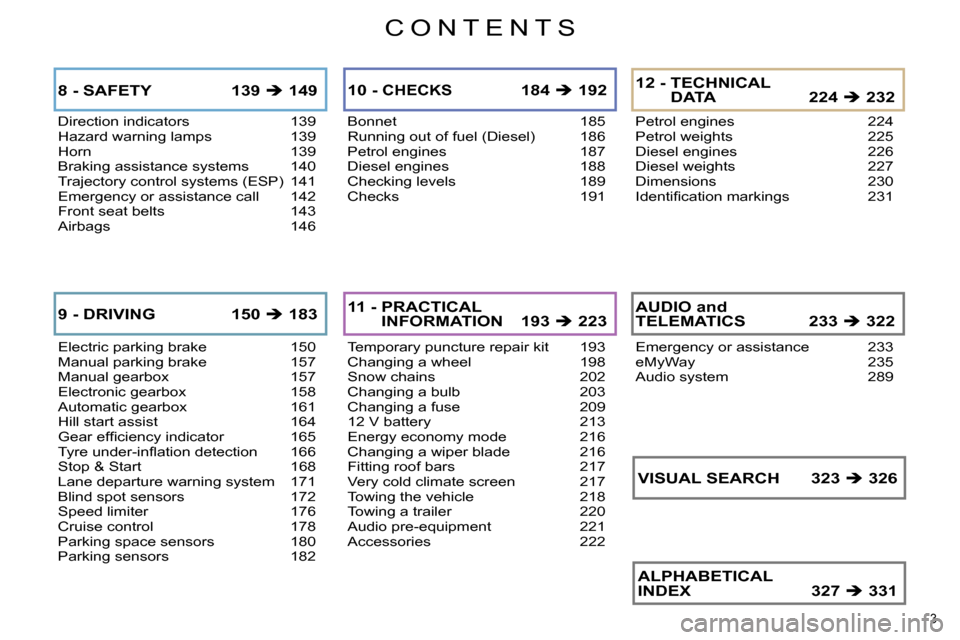
CONTENTS
3
Direction indicators 139
Hazard warning lamps 139
Horn 139
Braking assistance systems 140
Trajectory control systems (ESP) 141
Emergency or assistance call 142
Front seat belts 143
Airbags 146
8 - SAFETY 139 149
Electric parking brake 150
Manual parking brake 157
Manual gearbox 157
Electronic gearbox 158
Automatic gearbox 161
Hill start assist 164
Gear effi ciency indicator 165
Tyre under-infl ation detection 166
Stop & Start 168
Lane departure warning system 171
Blind spot sensors 172
Speed limiter 176
Cruise control 178
Parking space sensors 180
Parking sensors 182
9 - DRIVING 150 183
Bonnet 185
Running out of fuel (Diesel) 186
Petrol engines 187
Diesel engines 188
Checking levels 189
Checks 191
10 - CHECKS 184 192
Temporary puncture repair kit 193
Changing a wheel 198
Snow chains 202
Changing a bulb 203
Changing a fuse 209
12 V battery 213
Energy economy mode 216
Changing a wiper blade 216
Fitting roof bars 217
Very cold climate screen 217
Towing the vehicle 218
Towing a trailer 220
Audio pre-equipment 221
Accessories 222
11 - PRACTICAL
INFORMATION 193 223
Petrol engines 224
Petrol weights 225
Diesel engines 226
Diesel weights 227
Dimensions 230
Identifi cation markings 231
12 - TECHNICAL
DATA 224 232
Emergency or assistance 233
eMyWay 235
Audio system 289
AUDIO and
TELEMATICS 233 322
ALPHABETICAL
INDEX 327 331 VISUAL SEARCH 323 326
Page 47 of 340
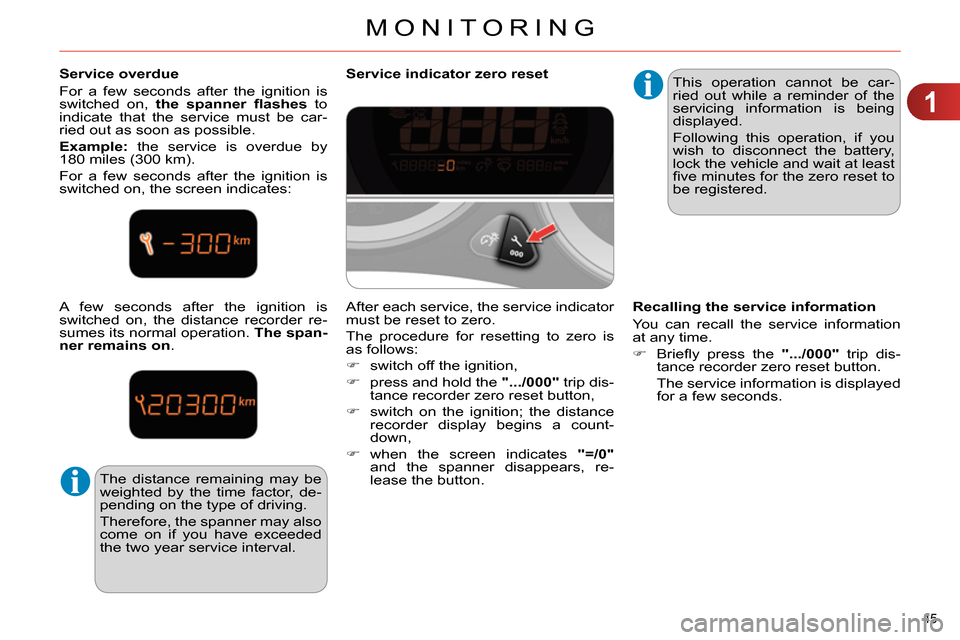
1
MONITORING
45
Service overdue
For a few seconds after the ignition is
switched on, the spanner fl ashes
to
indicate that the service must be car-
ried out as soon as possible.
Example:
the service is overdue by
180 miles (300 km).
For a few seconds after the ignition is
switched on, the screen indicates:
A few seconds after the ignition is
switched on, the distance recorder re-
sumes its normal operation. The span-
ner remains on
.
The distance remaining may be
weighted by the time factor, de-
pending on the type of driving.
Therefore, the spanner may also
come on if you have exceeded
the two year service interval.
Service indicator zero reset
This operation cannot be car-
ried out while a reminder of the
servicing information is being
displayed.
Following this operation, if you
wish to disconnect the battery,
lock the vehicle and wait at least
fi ve minutes for the zero reset to
be registered.
Recalling the service information
You can recall the service information
at any time.
Briefl y press the ".../000"
trip dis-
tance recorder zero reset button.
The service information is displayed
for a few seconds.
After each service, the service indicator
must be reset to zero.
The procedure for resetting to zero is
as follows:
switch off the ignition,
press and hold the ".../000"
trip dis-
tance recorder zero reset button,
switch on the ignition; the distance
recorder display begins a count-
down,
when the screen indicates "=/0"
and the spanner disappears, re-
lease the button.
Page 127 of 340
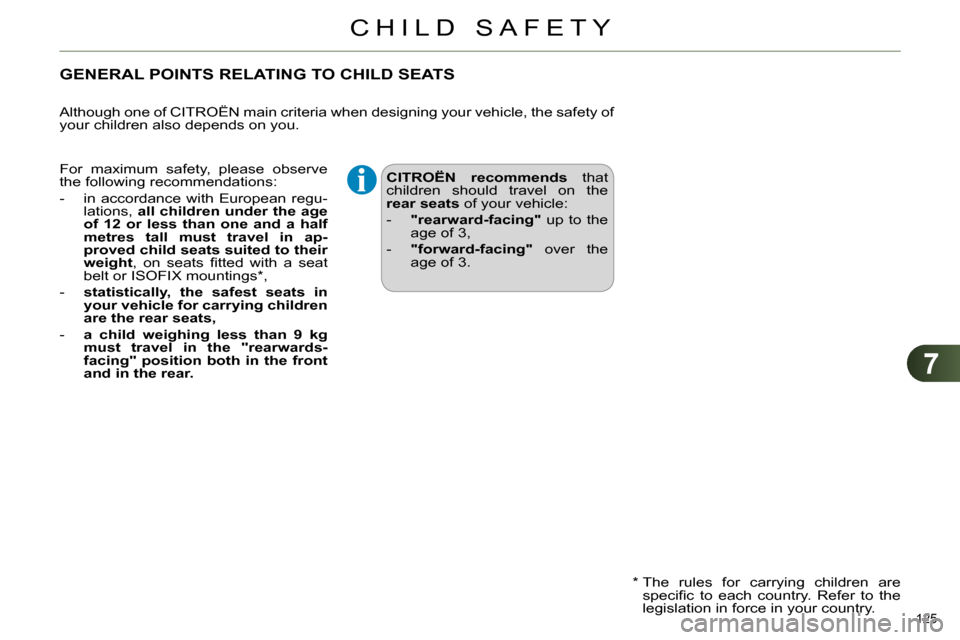
7
CHILD SAFETY
125
GENERAL POINTS RELATING TO CHILD SEATS
CITROËN recommends
that
children should travel on the
rear seats
of your vehicle:
- "rearward-facing"
up to the
age of 3,
- "forward-facing"
over the
age of 3.
Although one of CITROËN main criteria when designing your vehicle, the safety of
your children also depends on you.
*
The rules for carrying children are
specifi c to each country. Refer to the
legislation in force in your country.
For maximum safety, please observe
the following recommendations:
- in accordance with European regu-
lations, all children under the age
of 12 or less than one and a half
metres tall must travel in ap-
proved child seats suited to their
weight
, on seats fi tted with a seat
belt or ISOFIX mountings * ,
- statistically, the safest seats in
your vehicle for carrying children
are the rear seats,
- a child weighing less than 9 kg
must travel in the "rearwards-
facing" position both in the front
and in the rear.
Page 134 of 340
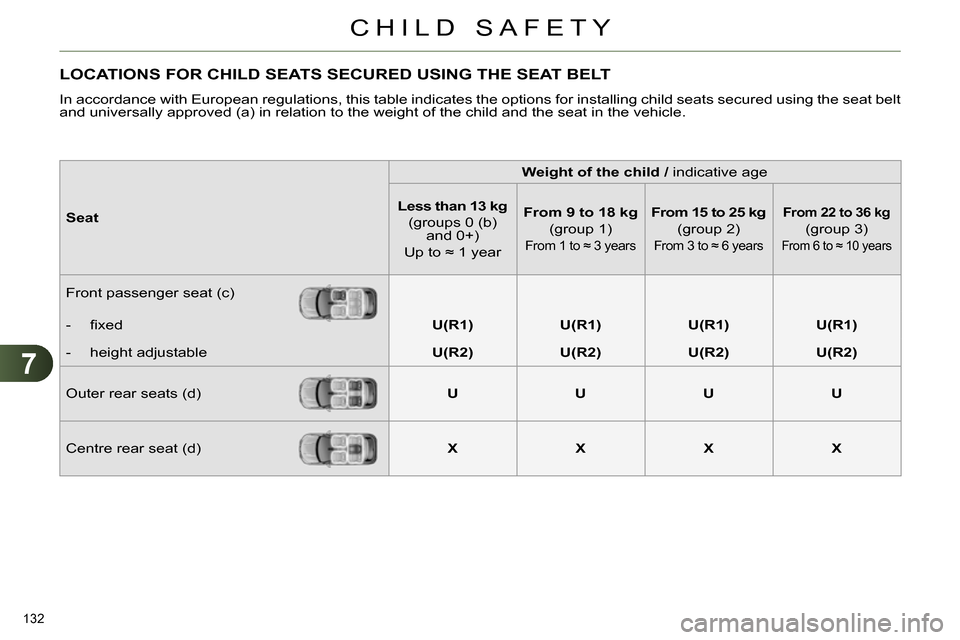
7
CHILD SAFETY
132
LOCATIONS FOR CHILD SEATS SECURED USING THE SEAT BELT
In accordance with European regulations, this table indicates the options for installing child seats secured using the seat belt
and universally approved (a) in relation to the weight of the child and the seat in the vehicle.
Seat
Weight of the child /
indicative age
Less than 13 kg
(groups 0 (b)
and 0+)
Up to ≈ 1 year
From 9 to 18 kg
(group 1)
From 1 to ≈ 3 years
From 15 to 25 kg
(group 2)
From 3 to ≈ 6 years
From 22 to 36 kg
(group 3)
From 6 to ≈ 10 years
Front passenger seat (c)
- fi xed
U(R1)
U(R1)
U(R1)
U(R1)
- height adjustable
U(R2)
U(R2)
U(R2)
U(R2)
Outer rear seats (d)
U
U
U
U
Centre rear seat (d)
X
X
X
X
Page 135 of 340
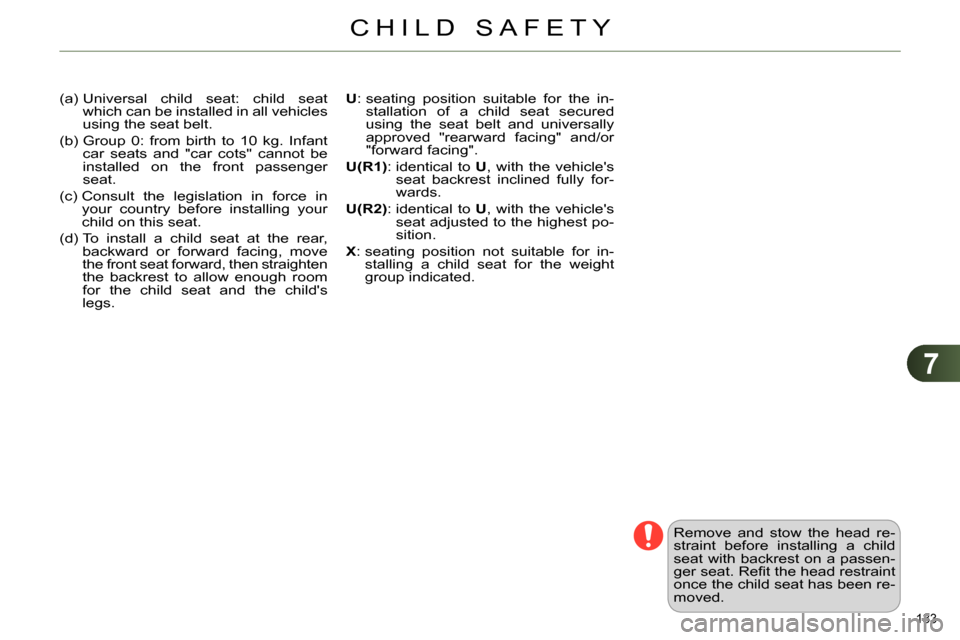
7
CHILD SAFETY
133
(a) Universal child seat: child seat
which can be installed in all vehicles
using the seat belt.
(b) Group 0: from birth to 10 kg. Infant
car seats and "car cots" cannot be
installed on the front passenger
seat.
(c) Consult the legislation in force in
your country before installing your
child on this seat.
(d) To install a child seat at the rear,
backward or forward facing, move
the front seat forward, then straighten
the backrest to allow enough room
for the child seat and the child's
legs.
Remove and stow the head re-
straint before installing a child
seat with backrest on a passen-
ger seat. Refi t the head restraint
once the child seat has been re-
moved.
U
: seating position suitable for the in-
stallation of a child seat secured
using the seat belt and universally
approved "rearward facing" and/or
"forward facing".
U(R1)
: identical to U
, with the vehicle's
seat backrest inclined fully for-
wards.
U(R2)
: identical to U
, with the vehicle's
seat adjusted to the highest po-
sition.
X
: seating position not suitable for in-
stalling a child seat for the weight
group indicated.
Page 138 of 340
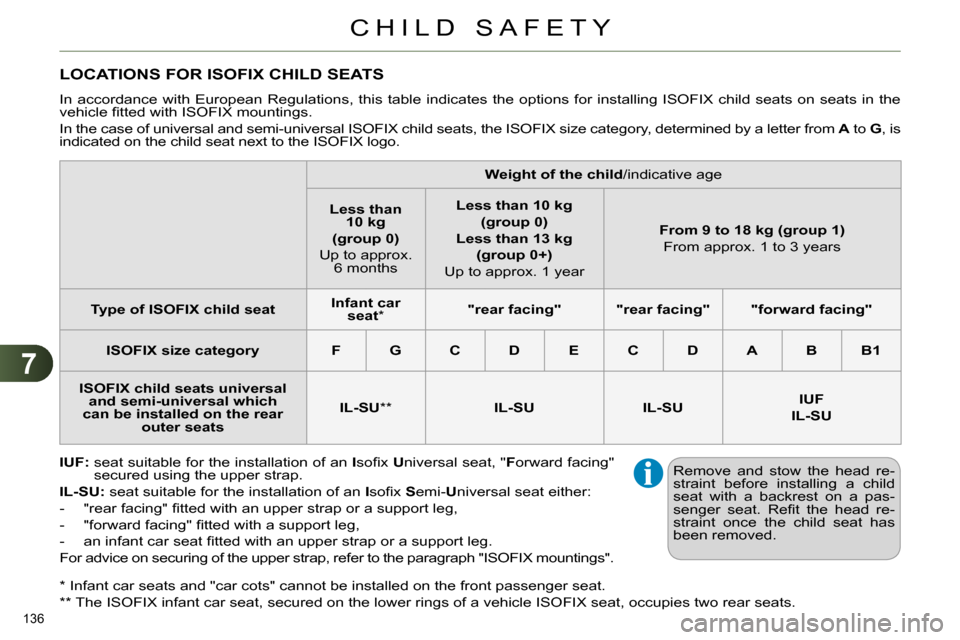
7
CHILD SAFETY
136
*
Infant car seats and "car cots" cannot be installed on the front passenger seat.
**
The ISOFIX infant car seat, secured on the lower rings of a vehicle ISOFIX seat, occupies two rear seats.
LOCATIONS FOR ISOFIX CHILD SEATS
In accordance with European Regulations, this table indicates the options for installing ISOFIX child seats on seats in the
vehicle fi tted with ISOFIX mountings.
In the case of universal and semi-universal ISOFIX child seats, the ISOFIX size category, determined by a letter from A
to G
, is
indicated on the child seat next to the ISOFIX logo.
IUF:
seat suitable for the installation of an I
sofi x U
niversal seat, " F
orward facing"
secured using the upper strap.
IL-SU:
seat suitable for the installation of an I
sofi x S
emi- U
niversal seat either:
- "rear facing" fi tted with an upper strap or a support leg,
- "forward facing" fi tted with a support leg,
- an infant car seat fi tted with an upper strap or a support leg.
For advice on securing of the upper strap, refer to the paragraph "ISOFIX mountings".
Weight of the child
/indicative age
Less than
10 kg
(group 0)
Up to approx.
6 months
Less than 10 kg
(group 0)
Less than 13 kg
(group 0+)
Up to approx. 1 year
From 9 to 18 kg (group 1)
From approx. 1 to 3 years
Type of ISOFIX child seat
Infant car
seat
*
"rear facing"
"rear facing"
"forward facing"
ISOFIX size category
F
G
C
D
E
C
D
A
B
B1
ISOFIX child seats universal
and semi-universal which
can be installed on the rear
outer seats
IL-SU
**
IL-SU
IL-SU
IUF
IL-SU
Remove and stow the head re-
straint before installing a child
seat with a backrest on a pas-
senger seat. Refi t the head re-
straint once the child seat has
been removed.
Page 219 of 340
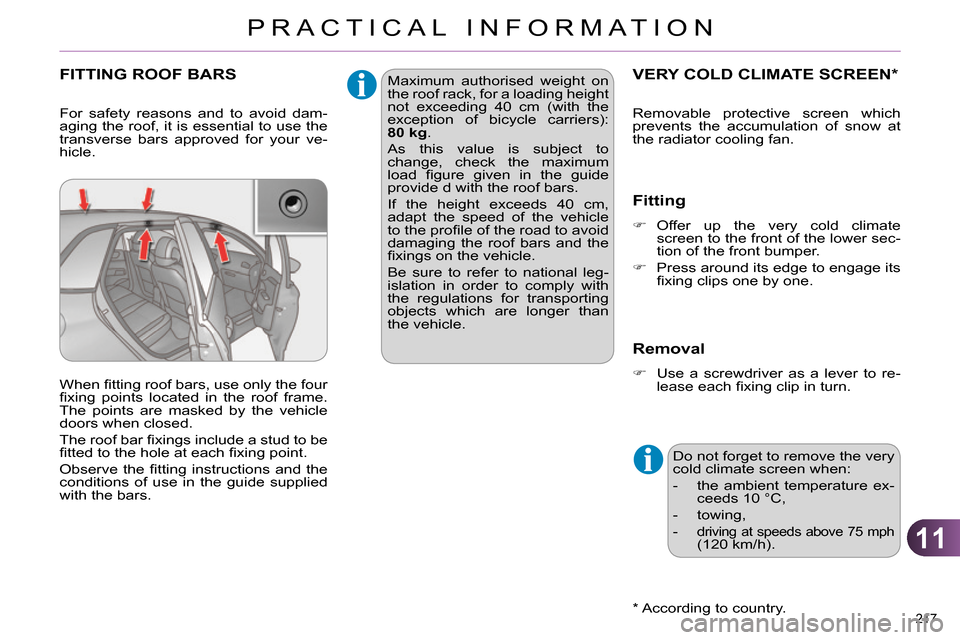
11
PRACTICAL INFORMATION
217
VERY COLD CLIMATE SCREEN *
* According to country.
Fitting
Offer up the very cold climate
screen to the front of the lower sec-
tion of the front bumper.
Press around its edge to engage its
fi xing clips one by one.
Removal
Use a screwdriver as a lever to re-
lease each fi xing clip in turn.
Do not forget to remove the very
cold climate screen when:
- the ambient temperature ex-
ceeds 10 °C,
- towing,
-
driving at speeds above 75 mph
(120 km/h).
Removable protective screen which
prevents the accumulation of snow at
the radiator cooling fan.
FITTING ROOF BARS
For safety reasons and to avoid dam-
aging the roof, it is essential to use the
transverse bars approved for your ve-
hicle.
When fi tting roof bars, use only the four
fi xing points located in the roof frame.
The points are masked by the vehicle
doors when closed.
The roof bar fi xings include a stud to be
fi tted to the hole at each fi xing point.
Observe the fi tting instructions and the
conditions of use in the guide supplied
with the bars.
Maximum authorised weight on
the roof rack, for a loading height
not exceeding 40 cm (with the
exception of bicycle carriers):
80
kg
.
As this value is subject to
change, check the maximum
load fi gure given in the guide
provide d with the roof bars.
If the height exceeds 40 cm,
adapt the speed of the vehicle
to the profi le of the road to avoid
damaging the roof bars and the
fi xings on the vehicle.
Be sure to refer to national leg-
islation in order to comply with
the regulations for transporting
objects which are longer than
the vehicle.
Page 220 of 340
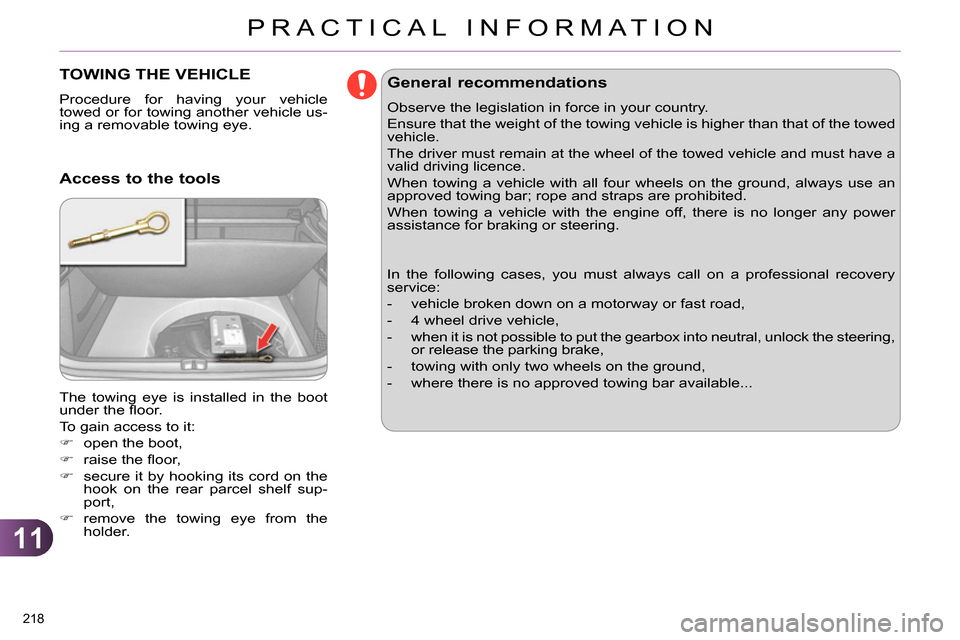
11
PRACTICAL INFORMATION
218
TOWING THE VEHICLE
Procedure for having your vehicle
towed or for towing another vehicle us-
ing a removable towing eye.
The towing eye is installed in the boot
under the fl oor.
To gain access to it:
open the boot,
raise the fl oor,
secure it by hooking its cord on the
hook on the rear parcel shelf sup-
port,
remove the towing eye from the
holder.
Access to the tools
General recommendations
Observe the legislation in force in your country.
Ensure that the weight of the towing vehicle is higher than that of the towed
vehicle.
The driver must remain at the wheel of the towed vehicle and must have a
valid driving licence.
When towing a vehicle with all four wheels on the ground, always use an
approved towing bar; rope and straps are prohibited.
When towing a vehicle with the engine off, there is no longer any power
assistance for braking or steering.
In the following cases, you must always call on a professional recovery
service:
- vehicle broken down on a motorway or fast road,
- 4 wheel drive vehicle,
- when it is not possible to put the gearbox into neutral, unlock the steering,
or release the parking brake,
- towing with only two wheels on the ground,
- where there is no approved towing bar available...
Page 222 of 340

11
PRACTICAL INFORMATION
220
TOWING A TRAILER
We recommend the use of genu-
ine CITROËN towbars and their
harnesses that have been tested
and approved from the design
stage of your vehicle, and that
the fi tting of the towbar is en-
trusted to a CITROËN dealer or
a qualifi ed workshop.
If the towbar is not fi tted by a
CITROËN dealer, it is impera-
tive that it is fi tted in accordance
with the vehicle manufacturer's
instructions.
The rear parking sensors will
be deactivated automatically if
a genuine CITROËN towbar is
used.
Towbar suitable for the attachment of a
trailer or installation of a bicycle carrier,
with additional lighting and signalling.
Your vehicle is primarily designed for
transporting people and luggage, but it
may also be used for towing a trailer.
Driving with a trailer places greater de-
mands on the towing vehicle and the
driver must take particular care.
Driving advice
Distribution of loads
Distribute the load in the trailer so
that the heaviest items are as close
as possible to the axle and the nose
weight approaches the maximum
permitted without exceeding it.
Air density decreases with altitude, thus
reducing engine performance. Above
1 000 metres, the maximum towed load
must be reduced by 10 % for every
1 000 metres of altitude.
Side wind
Take into account the increased
sensitivity to side wind.
Cooling
Towing a trailer on a slope increases
the temperature of the coolant.
As the fan is electrically controlled, its
cooling capacity is not dependent on
the engine speed.
To lower the engine speed, reduce
your speed. The maximum towed load on a long in-
cline depends on the gradient and the
ambient temperature.
In all cases, keep a check on the cool-
ant temperature.
If the warning lamp and the
STOP
warning lamp come
on, stop the vehicle and
switch off the engine as
soon as possible.
Braking
Towing a trailer increases the braking
distance.
To avoid overheating of the brakes on a
long mountain type of descent, the use
of engine braking is recommended.
Tyres
Check the tyre pressures of the towing
vehicle and of the trailer, observing the
recommended pressures.
Lighting
Check the electrical lighting and sig-
nalling on the trailer.
Refer to the "Technical data" section for
details of the weights and towed loads
which apply to your vehicle.
Page 227 of 340

12
TECHNICAL DATA
225
*
The weight of the braked trailer can be increased, within the GTW limit, if the GVW of the towing vehicle is reduced by an
equal amount. Warning: towing using a lightly loaded towing vehicle may have an adverse effect on its road holding.
The GTW and towed load values indicated are valid up to a maximum altitude of 1 000 metres; the towed load mentioned
must be reduced by 10 % for each additional 1 000 metres of altitude.
The speed of a towing vehicle must not exceed 60 mph (100 km/h) (comply with the legislation in force in your country).
High ambient temperatures may result in a reduction in the performance of the vehicle to protect the engine; if the ambient
temperature is above 37 °C, limit the towed load.
WEIGHTS AND TOWED LOADS (in kg)
Petrol engines
VTi 95
VTi 120
THP 155
Gearboxes
Manual
Manual
Automatic
Electronic
Model codes:
NC...
8FR0
5FS0
5FS9
5FS9/D
5FV8/P
- Unladen weight
1 200
1 205
1 270
1 275
- Kerb weight
1 275
1 280
1 345
1 350
- Gross vehicle weight (GVW)
1 720
1 765
1 755
1 805
- Gross train weight (GTW)
on a 12 % gradient
2 920
3 065
3 055
3 205
- Braked trailer (within the GTW limit)
on a 12 % gradient
1 200
1 300
1 300
1 400
- Braked trailer * (with load transfer
within the GTW limit)
1 450
1 550
1 550
1 560
- Unbraked trailer
635
640
670
675
- Recommended nose weight
75
75
75
75